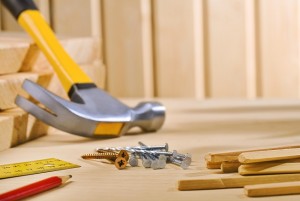 If you’ve ever tried and failed to tackle a home improvement project with proper planning, you know how costly your mistakes can end up being. Fortunately, you’re not alone. There are many common mistakes homeowners make when doing remodeling projects. We all have good intentions when we gather our supplies from the home improvement store and clear our weekends of any other plans, but even the best laid plans go awry.
If you’ve ever tried and failed to tackle a home improvement project with proper planning, you know how costly your mistakes can end up being. Fortunately, you’re not alone. There are many common mistakes homeowners make when doing remodeling projects. We all have good intentions when we gather our supplies from the home improvement store and clear our weekends of any other plans, but even the best laid plans go awry.
Improper Planning
The key to a good plan is to think it out first. This involves developing a budget and schedule to flesh out your plan of attack. Crunch the numbers, make a list of the materials you’ll need, the time it will all take, and what tools and equipment are necessary to complete the job. Try to anticipate what could go wrong and make a contingency plan.
Lean Budget
When you create your budget, don’t just figure in the hard numbers for materials and labor if you’re hiring a contractor; give yourself some wiggle room so you don’t stress out when the budget has to stretch further than you originally thought. Calculate how much the project will cost, then add 20 percent to that, advises Better Homes and Gardens. Perhaps you calculated wrong on the material you’ll need and it turns out you need to make another run to the home improvement store. Or maybe when you demolished the bathroom wall to enlarge it, you didn’t count on mold being present that you’d have to pay to have removed. At least now you will have the breathing room within your budget to complete the project.
Don’t be Cheap
If money is tight, you may be trying to skimp here and there on materials. But if you decide to work with sub-par flooring or counter tops, for example, you could be replacing them fairly soon down the road because they just don’t last. Likewise, if you don’t invest in high-efficiency windows, the heat loss will cost you money for years to come. Make the investment, no matter how much it hurts your wallet, to get the good stuff. It will pay off for you later down the road. Remember: anything worth doing is worth doing right. If you can’t afford to undergo a high-quality home renovation, it’s recommended that you hold off until you can comfortably purchase the best materials possible.
Cut Where You Can
That being said, there are ways you can cut costs that will never be evident in the final project. You can pick up salvaged wood, decor items and even drywall at a fraction of the price that you would pay for new. Hit yard sales, auctions, flea markets, estate sales and salvage stores. A good contractor will make it all flow seamlessly together for a top-notch look.
Changing Plans Mid-Way
Changing your mind halfway through the project can have costly results for you. Your contractor will have to demolish what he’s done already and start over, costing you in time and materials. This is where proper planning comes in. Make sure the scope of work that’s outlined in the original contract is exactly what you want.
Don’t Get Outrageous
If every home in your neighborhood is a quaint little ranch and you put on a contemporary addition or paint it a garish color, your home is going to stick out like a sore thumb. While your idea may look cutting-edge in another type of neighborhood, it may just not work with the one you’re in. While a little originality is a good thing, try to blend the overall design with that of your neighborhood.
The next time you’re planning a remodel, consider these common mistakes and try to avoid them. It will save you headaches and money.